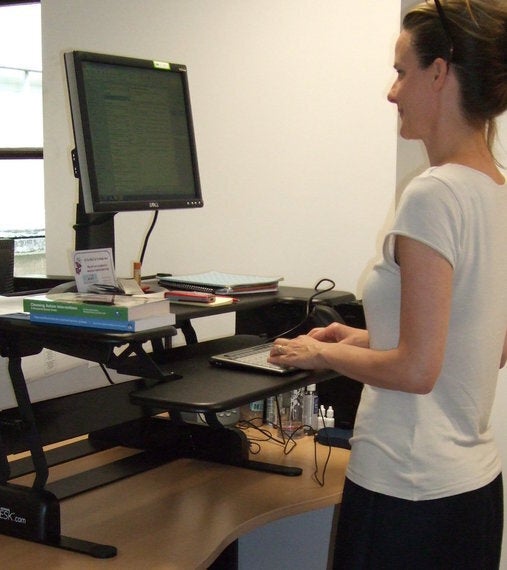I love my sit-stand desk. It truly has transformed my working life.
After suffering a repetitive strain injury that left me in so much pain that I was unable to use my hands for a while, I now take good workstation set up very seriously.
And my sit-stand desk plays a big part in keeping me pain free.
Here's how:

Move, move, move
My sit-stand desk allows me to bring more movement into my work day. I can stand and sit as often as I like or need to, so if I feel a ping in my back, neck or shoulders, I know it's time to change position again.
Banish autopilot
Changing position frequently makes me think about my body positioning. So where I once sat down in the morning and went on autopilot, I now have the opportunity to rethink and readjust every time I move my desk. My posture is improved as a result and my pain is less - much less.
Up and ready
My sit-stand desk makes dynamic movement easier to do too. Because I'm already standing, walking to a colleague's desk doesn't seem as big a chore as it did when I was sitting all the time. I suppose because I'm already on my legs, and don't have to do the work of getting up, I'm more likely to walk around.
Why you need a good workstation assessment
For all of its positive benefits, a sit-stand desk isn't a magic pill because there is more to protecting yourself from musculoskeletal pain than just alternating sitting and standing.
A comprehensive workstation assessment is necessary to show you how to get the most out of your sit-stand desk or your sitting-only desk. A workstation assessment should also include an analysis of how and how much you use digital devices at work, at home and everywhere in between.
Here's why you need more than just a sit-stand desk:
Screen up/head up
Hunching over and staring down at a laptop isn't good for your body whether you are sitting or standing. The top of your screen has to be at eye level at all times.
Your head weighs about 10lbs when it's upright on top of your spine. But when you look down, the strain your head puts on your spine increases incrementally as you bend your neck/head farther down.
So keep your head up. And keep reminding yourself throughout your day to do this. Because it applies to your desk at work, on the bus ride home, on the sofa in the evening and everywhere else you are looking at your smartphone. (Completing all existing levels of Candy Crush isn't a good reason to hurt yourself.)
No resting
Your body is an interconnected system of muscles, tendons, fascia, etc. This means that what goes on in one area of your body is having a knock on effect in other areas.
If you're typing, you shouldn't be resting. This applies to wrists, forearms, elbows, or any other body part you might be leaning on.
So, for example, if you lean on your wrists while you type, you are essentially cutting your fingers off from the rest of your body. You are forcing your fingers to do the work of typing all on their own.
It's like trying to throw a ball using only your hand, and nothing of your arm. That's ridiculous. Pick something up right now and try to throw it using only your hand (no arm). See how difficult that is?
It's fine to rest in between bouts of typing, but not during.
Keep your arms close
You don't walk around the streets with your arms extended out in front of you - unless you're Frankenstein - so you shouldn't do it at your desk either.
Again, whether sitting or standing, your arms should be kept close to your body - where they would be if you were walking down the street. If you are reaching out for your mouse - in front, to the side, wherever - you're causing unnecessary strain in your whole body.
Pull your mouse closer and keep your upper arms alongside your body. This will get your forearms nearer too.
Again - Move, move, move
You can't sit all day. You can't stand all day. You can't do one thing all the time. Our bodies were built to move. So move, move, move as much as possible throughout your day. You don't have to sweat to get the benefits.
It's hard in the office because most workplaces don't make regular movement socially acceptable. I was in a meeting the other day and people were getting angry that I didn't want to sit down. I could hear and think just as well standing (maybe better), but still it was making colleagues visibly agitated.
We've got to break away from the mindset that moving at work is weird. Being still is what's weird.
So, definitely get a sit-stand desk, but don't expect it to do everything. You need a good workstation assessment to show you how to get the most out of your set up - whatever it is.
This blog first appeared on Safe Hands, specialists in comprehensive computer workstation assessments.